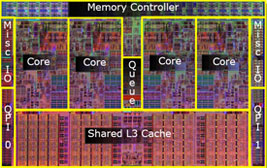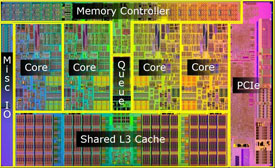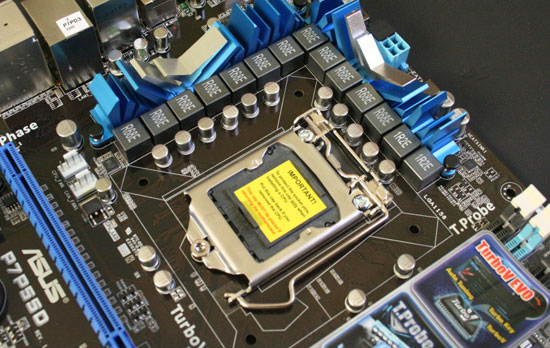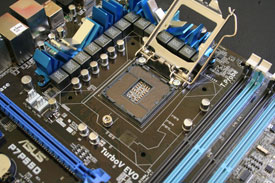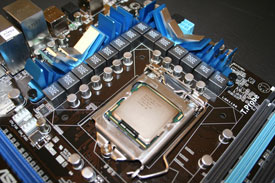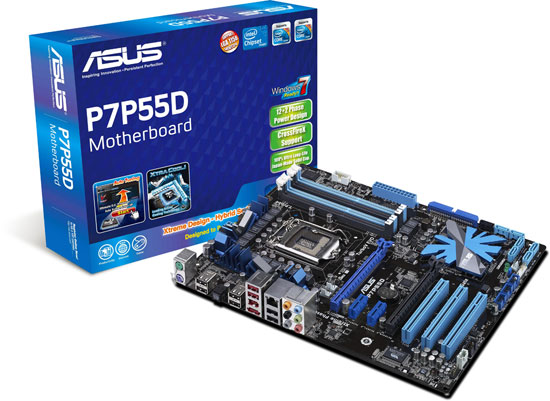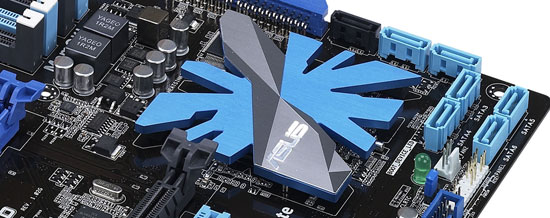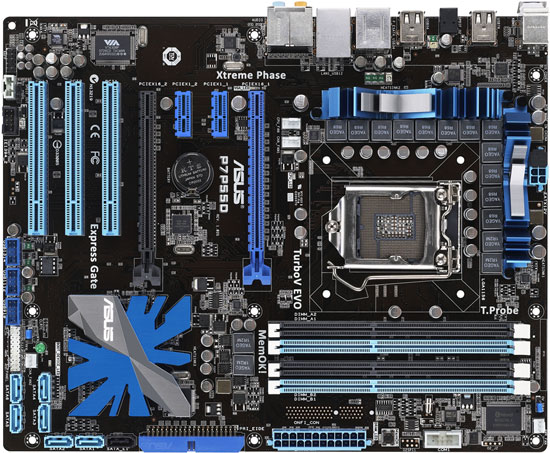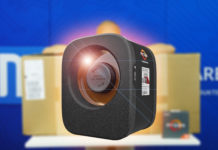Intel has launched its second version of Nehalem architecture. With Lynnfield it targets the mid-range and performance segment. We see how Lynnfield stands up to big brother Bloomfield and AMD’s Phenom II architecture.
Intel has dominated the high-end segment since the announcement of the Core i7 series of the Nehalem architecture. Even if AMD has made progress and brought forward its more competitive Phenom II family, it has remained a price/performance product. Both AMD and Intel knows that Phenom II can’t compete with Core i7 in terms of raw performance, but through lower prices and cheaper motherboards AMD has been able to offer an affordable platform that competes with Intel’s Core 2 architecture in the mid-range and performance segments.
The Core i7 processors, code-named Bloomfield, and not the least the LGA1366 platform as a whole has not been able to compete in term of price. That’s where the LGA1156 platform and Lynnfield comes into the picture. Even if Lynnfield, as you will become aware of, actually contains more transistors than Bloomfield, Intel has lowered manufacturing costs of the processor and not the least the motherboard and platform as a whole.
Lynnfield cores
The base of Lynnfield is not very different from Bloomfield, but the few changes Intel has made are well thought-through and turn the LGA1156 platform into a more affordable/competitive product, not just in comparison to AMD’s Phenom II family but also Intel’s own high-end platform with the Bloomfield processors. The time has come for us to look at the details separating the two processor architectures and what makes Lynnfield such an interesting product.
Lynnfield is not very different from Bloomfield when it comes to the actual processor core. In short, one memory channel has been removed and there is added support for PCI-Express directly inside the processor. If you look at just the processor you might wonder what the big deal is, but when you look at the entire platform you realize it might not be such a bad idea after all.
As for the memory controller it’s not such a drastic move as it may seem, to remove a whole channel. Many tests have shown that Bloomfield can achieve extremely high system memory bandwidths, but when it comes to real-life use few applications can actually take advantage of this. Lynnfield is not intended to be the best performing platform and then dual memory channels are more than enough.
Since the PCI Express controller is not located inside the processor the need for a northbridge has been completely eliminated, which is a big advantage for the platform as a whole. Not only from an economical standpoint but it also has positive effects on the power consumption, and brings down the surface requirements. Power consumption and space are often critical elements with stationary computers but we are certain that notebook builders and designers of embedded systems are even happier about this.
To eliminate the northbridge completely it had to move the DMI interface that connects the northbridge and southbridge onto the processor. So to conclude: the PCI Express from the northbridge to the processor, the DMI interface into the processor for connecting to the southbridge and one less memory channel.
Before we look at the different processor models Intel has presented we will peek at Intel’s P55 Express chipset and LGA 1156 platform.
We have already discussed how Intel has changed the Lynnfield architecture and baked in additional functionality into the processor, from the northbridge. With PCI Express and DMI inside the processor Intel has cast the need for a northbridge aside, which makes the Intel P55 chipset simply a southbridge. And compared to Intel’s 4 series of chipsets, used with the LGA 775 platform, the differences are many.
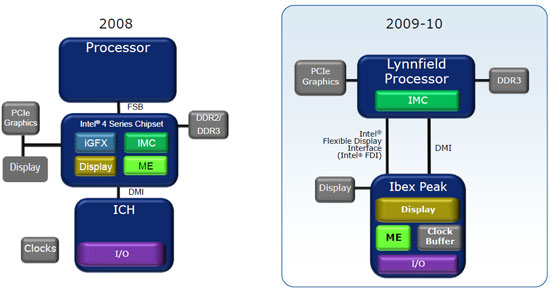
Intel’s 4 series is used with the Core 2 platform while the new 5 series is used with the Bloomfield/Lynnfield platforms
The chipsets communicate with the processor through the DMI bus and handles the connection to the different interfaces like USB, SATA, Ethernet, sound chips and much more.
But with Lynnfield and LGA1156 it’s now the processor that sends the information, not just to the memory but also the graphics cards thanks to the integrated PCI Express 2.0 controller. The bandwidth is limited to x16 electrical, which is enough to run one graphics card at full capacity, but with two cards the bandwidth will be limited to “just” x8 electrical per card, which could be limiting at times of tremendous loads. Though it rules out support for three or four graphics cards with the Lynnfield platform. Motherboards with PCI Express bridges are in development though, which could open up for 3-way SLI or CrossFireX with the Lynnfield platform.
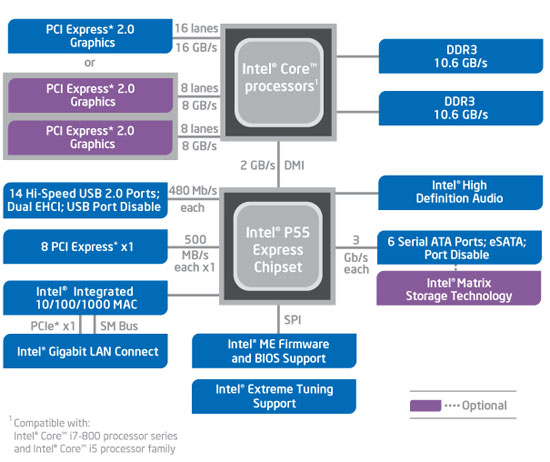
Intel’s P55 Express chipset
Intel’s design of Lynnfield and the P55 Express chipset enables motherboard makers to reduce manufacturing costs since the northbridge is no longer needed. The PCI Express bandwidth limitation aside, there are some question marks surrounding the bandwidth of the DMI bus. Even if 2GB/s is a lot there are extreme storage solution that can achieve transfer rates over 1GB/s, and with SATA 6Gbps and USB 3.0 around the corner data traffic is going to increase more than a bit.
We guess that Lynnfield’s DMI bus won’t cause problems anytime soon, and to extreme users there is still the LGA1366 platform as the faster/better alternative.
Intel P55 Express is a considerably more power efficient and cheaper chipset than Intel X58, and this benefits the entire LGA1156 platform.
Alas, Intel has, despite the great similarities with previous Land Grid Array platforms (1366 and 775), once again tried out some new standards and formats, something we will look at next.
Lynnfield looks much like Bloomfield with its oblong contact surfaces for the pins of the socket. The number of pins has been reduced from 1366 to 1156 as a result of the internal changes that were discussed on the previous pages.
Even if Lynnfield has more transistors than Bloomfield it has one memory channel less and a narrower data bus, which reduce the need for contacts to the chipset.
When it comes to the socket it looks like the Bloomfield socket and beside the slightly redesigned locking mechanism for the processor it works in pretty much the same way. Back when Core i7 launched we weren’t that happy that the mounting holes had changed since Socket 775, which reduced most after-market coolers to useless, until new mounting kits where released. There might be a point for this, to hinder old and sub-par cooler to be mounted by mistake. Why Intel once again changes the layout of the holes from Socket 1366 to Socket 1156 is a mystery though. The new hole dimensions are as follows:
| Socket: | Dimensions: |
|---|---|
| LGA775 | 72x72mm |
| LGA1156 | 75x75mm |
| LGA1366 | 80x80mm |
Except from tests with Intel’s stock cooler we have also done some tests with Noctua NH-U12P, which is one of several cooler that have been upgraded with support for the LGA1156 platform through new mounting kits.
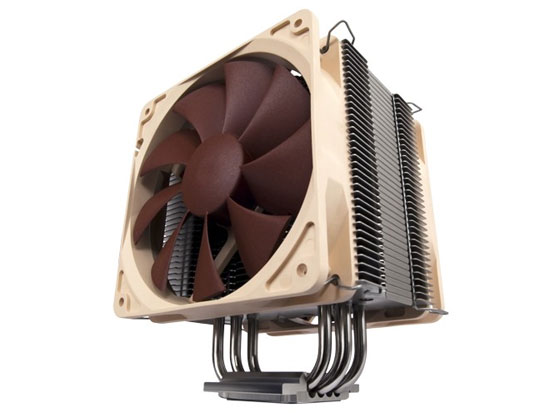
In our first test of Intel’s Lynnfield processors and P55 Express chipset we used a motherboard from ASUS, which we will present next.
ASUS has one of the broadest assortments of Intel P55 Express motherboards and P7P55D is actually one of the cheaper. It may sound boring, but at the same time it becomes an interesting guideline for Lynnfield and the LGA1156 platform that is intended as a more affordable alternative for performance seekers.
ASUS P7P55D of course supports both Core i5 and Core i7 processors from the Lynnfield family, but will also house the next generation LGA1156 processors that are expected to arrive soon. We have already seen what Intel’s P55 Express chipset offers in terms of functionality, which is the very base of ASUS P7P55D.
| Specifications | ASUS P7P55D |
|---|---|
| CPU | LGA1156 socket with Intel Core i7 and Core i5 processors |
| Chipset | Intel P55 Express Chipset |
| Memory |
4 x DDR3 DIMM, max 16GB. Dual channels DDR 2133/1600/1333/1066MHz modules. With Extreme Memory Profile (XPM) support |
| Expansion slots | 1 x PCI Express 2.0 x16 slot (single at x16) 1 x PCI Express 2.0 x16 slots (@x4 mode, 2.5GT/s) 2 x PCI Express 2.0 x1 (2.5GT/s) 3 x PCI |
| Multi-GPU support | ATI CrossFireX and SLI |
| Storage | 7 x SATA 3 GB/s ports (6 Intel P55, 1 Marvell JMB363) 1 x eSATA 3Gb/s 1 x IDE 133/100/66/33 for two 2 IDE drives, 1 x Floppy |
| LAN | Realtek 8112L Gigabit LAN with AI NET2 |
| Audio | VIA® VT1828S 8 channel High Definition CODEC Optical S/PDIF, Dolby Home Theater |
| IEEE1394 | VIA® 6308P controller with 2 x IEEE 1394a ports |
| USB | 14 x USB 2.0 (6 internal and 8 external ports) |
| I/O Panel |
1 x PS/2 for keyboard (Purple) |
| Internal I/O connections | 3 x USB ports with 6 additional USB ports 1 x IDE connector 7 x SATA connectors 1 x CPU fan connector 2 x can fan connector (1×4-pin, 1×3-pin) 1 x Power supply fan connector 1 x IEEE1394a connector Front panel audio connector 1 x S/PDIF Out connector CD audio input 24-pin ATX Power connector 1 x 8-pin ATX 12V Power connector System Panel (Q-connector) 1 x MemOK! button |
| BIOS | 16 Mb Flash ROM, AMI BIOS, PnP, DMI2.0, WfM2.0, SM BIOS 2.5, ACPI 2.0a, Multi-language BIOS, ASUS EZ Flash 2, ASUS CrashFree BIOS 3 |
| Monitoring | CPU/System temperature detection CPU/System Power fan speed detection, CPU overheating, CPU/System/Power fan fail warning, CPU/System fan speed control |
| ASUS unique features | ASUS Hybrid Processor – TurboV EVO – Auto Tuning, TurboV and Turbo Key ASUS Hybrid Phase – T.Probe Technology for Active Cooling – 12+2 Phase Power Design ASUS Hybrid OS – Express Gate ASUS Xtreme Design ASUS Exclusive Features – MemOK! – ASUS EPU ASUS Quiet Thermal Solution – ASUS Fanless Design: Stylish Heat-sink solution – ASUS Fanless Design: Stack Cool 3 – ASUS Fan Xpert ASUS Crystal Sound – ASUS Noise Filter ASUS EZ DIY – ASUS Q-Shield – ASUS Q-Connector – ASUS O.C. Profile – ASUS CrashFree BIOS 3 – ASUS EZ Flash 2 – ASUS MyLogo 2 – Multi-language BIOS |
| ASUS unique overclocking features | Precision Tweaker 2: – vCore: Adjustable CPU voltage at 0.00625V increment – vIMC: 97-step IMC voltage control – vDRAM Bus: 81-step DRAM voltage control – vPCH: 2-step chipset voltage control – vCPU_PLL: 4-step reference voltage control SFS (Stepless Frequency Selection) – Internal Base Clock tuning from 80MHz up to 500MHz at 1MHz increment – PCI Express frequency tuning from 100MHz up to 200MHz at 1MHz increment Overclocking Protection: – ASUS C.P.R.(CPU Parameter Recall) |
| ASUS Q-Design | ASUS Q-LED (CPU, DRAM, VGA, Boot Device LED) ASUS Q-Slot ASUS Q-DIMM |
| Formfactor | ATX Form Factor 30.5 cm x 24,4 cm |
| Price | $140 |
Let’s look at the board.
The first you notice with the motherboard is that the top PCI Express x16 slot is closer to the CPU socket than we’re used to. The reason, as we’ve mentioned a few times, is that Intel has removed the need for a northbridge with all the necessary functions integrated into the Lynnfield processors instead.
All of the action instead happens in the southbridge located under the very slim heatsink in the lower right corner. Here we see yet another perk of the Intel P55 Express chipset, no noisy cooling required to keep temperatures down.
When we’re on the topic of cooling we see that ASUS has covered a portion of the power circuits with oblong heatsinks. ASUS P7P55D ships with 12+2 phase power supply, which should be sufficient for most, but at the same time not as impressive, on paper, as some other more expensive P55 boards we’ve seen.
The layout of the board needs few comments. As usual we have the SATA and IDE connectors at the bottom next to a set of extra USB inputs and front panel connector. The power connectors are suitably placed near the edge of the motherboard, which should cause as little cable management problems as possible. Above the 24-pin ATX connector we find ASUS MEM OK! button that can be used when the memory isn’t playing along.
As expected, the board has four memory slots, two for each memory channel. Even if there are P55 motherboards with more memory slots than this, they are often quite expensive. The memory support is an interesting detail with Lynnfield as many companies have flooded the market with new memory kits specially designed for the platform. We got a pair of the first from Corsair.
As mentioned more than a few times, one of the greater news about the LGA1156 platform is that the Lynnfield processors only has dual memory channels at its disposal. This means that bandwidth won’t be anywhere near that of big brother LGA1366 and its triple-channel memory controller, but it also adds some confusion to DIY builders.
Unlike the LGA1366 platform, memory modules should instead be used in even numbers, 2, 4 or in some cases 6. This means that all of the triple-channel kits that have flooded the market since Intel’s launch of Bloomfield are useless. Two of these kits on one Intel P55 motherboard with six memory slots is the only use we can see, otherwise memory kits with three modules only cause problems with the Lynnfield platform.
Just in time for our Lynnfield article we got a parcel from Corsair containing one of the more interesting DDR3 kits for LGA1156 systems. Corsair Dominator CMD8GX3M4A1600C8 is the name of the kit and it consists of no less than four 2GB DDR3-1600 memories.
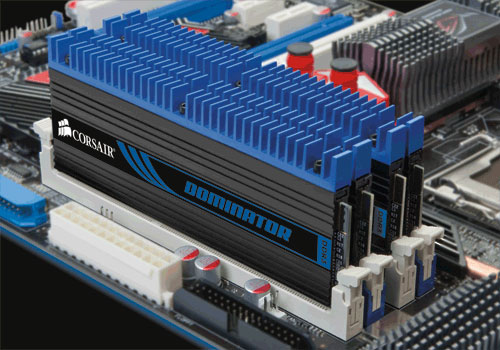 |
|
|---|---|
| Specifications | Corsair CMD8GX3M4A1600C8 |
| Clock frequency | 1600MHz / PC3-12800 |
| Memory timings | 8-8-8-24 |
| Memory voltage | 1,65V |
| Capacity | 8GB, (4 x 2GB) |
| Price | ~$250 |
Even if Lynnfield doesn’t support any speeds above 1333MHz, officially, there is nothing stopping you from pushing these modules quite a bit higher than that and Corsair’s 8GB kit promises a lot more than just 1333MHz.
Due to a lack of time we will hold off any detailed overclocking of the memory modules, but we’re confident to say that they work very well with the Lynnfield platform and for $250 you will fill every memory need of Intel’s new platform. Corsair has announced that this kit is intended for those aiming to achieve maximal memory capacity, it has other models intended for extreme overclocking. We will cover the Lynnfield-tailored memory market in coming articles and news.
Time to move on to what most of you are most likely waiting for, a presentation of the Lynnfield processors.
At the launch of the Lynnfield architecture Intel has presented three models using it, but we are convinced there will be additional models in the near future. The table below conclude where Lynnfield end up in comparison to Bloomfield.
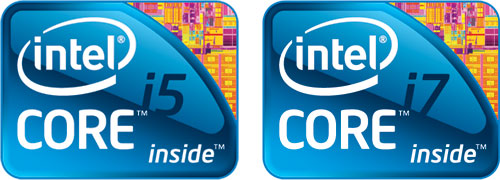
| Model | Cores/threads | Frequency | Turbo Boost | Cache | Node | TDP | Price |
|---|---|---|---|---|---|---|---|
| Core i7 975 | 4 / 8 | 3.33GHz | 3.60GHz | 8MB | 45nm | 130W | $999 |
| Core i7 965 | 4 / 8 | 3.20GHz | 3.46GHz | 8MB | 45nm | 130W | $999 |
| Core i7 950 | 4 / 8 | 3.06GHz | 3.33GHz | 8MB | 45nm | 130W | $562 |
| Core i7 940 | 4 / 8 | 2.93GHz | 3.20GHz | 8MB | 45nm | 130W | $562 |
| Core i5 870 | 4 / 8 | 2.93GHz | 3.60GHz | 8MB | 45nm | 95W | $562 |
| Core i5 860 | 4 / 8 | 2.80GHz | 3.46GHz | 8MB | 45nm | 95W | $284 |
| Core i7 920 | 4 / 8 | 2.66GHz | 2.93GHz | 8MB | 45nm | 130W | $284 |
| Core i5 750 | 4 / 4 | 2.66GHz | 3.20GHz | 8MB | 45nm | 95W | $196 |
Even though some of the initial frequencies match those of the models of the 900 series it remains to be seen how the 800 and 700 series stand up with their aggressive Turbo Boost feature. This should prove very suitable for games and other less multi-threaded applications.
The top model of the Core i7-8xx family is called Core i7-870 and the separating features include one less memory channel and some extra transistors for the PCI Express controller. The number of transistors for Lynnfield lands at 774 million, which is slightly more than the 731 million transistors of Bloomfield (LGA1366 Nehalem).

Intel Lynnfield Core i7-870
For the lower segments Intel has announced the first Core i5 processor with 2,66GHz clock frequency and the same features as the models of the Core i7 series, except the removal of HyperThreading. This means that the processor is limited to four threads, unlike Core i7 models that can handle eight threads. With maximal Turbo Boost Core i7-750 reaches 3.20GHz clock frequency, which is enough to break most dual-core models on the market.
In between we find Core i7-860 that has a bit lower clock frequency than Core i7-870 but also priced much lower. We have only Intel’s Core i7-870 processor available for testing, but we hope to complete with other models soon.
We will look closer how Turbo Boost works and what to expect from this exciting function.
When it comes to Intel’s processors of today the clock frequencies don’t tell the whole truth. Intel has moved the focus from clock frequency to power consumption. As most overclockers know there is often a margin with all processors, especially with efficient cooling. Intel has used this by allowing the processor to overclock itself if the temperatures are under control and the load is not too high. Intel calls this feature Turbo Boost and introduced it with the Bloomfield architecture. It can advance one multiplier with all cores and one additional multiplier in single-threaded applications under certain circumstances. Lynnfield takes all of this one step further and can increase the multiplier multiple steps. This is of course a good thing for end-users, but far from easy to test in an objective way.

In the end it means that Lynnfield is capable of operating at higher clock frequencies than specified, as long as one or more cores are running idle. Something that optimizes performance additionally depending how you use it. Even though Core i7-870 can overclock from 2.93GHz to 3.60GHz with Turbo Boost it can only do so with one core active, which means that power consumption will never rise above the specified TDP envelope.
When three or four cores are loaded the clock frequency can rise up to 3.20GHz, seen in the screenshot below. The next step is 3.46GHz which can happen when only two cores are loaded and last 3.60GHz when only one core is loaded. This is just as high as the Turbo mode of Core i7-975 Extreme Edition.
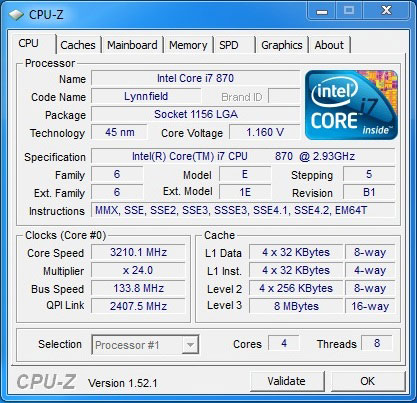
It’s time to present our test system before we move on with the benchmarks.
 |
|
|---|---|
| Motherboards | ASUS P7P55D (LGA1156) MSI X58 Eclipse SLI (LGA1366) ASUS Crosshair III Formula (AM3) |
| Processors | Intel Core i7-870 2,93GHz (LGA1156) Intel Core i7-965 3,20GHz (LGA1366) AMD Phenom II X4 965 3,40GHz (AM3) |
| Memories | Corsair TR3X6G1866C9D (3x2GB) @ 1333MHz 9-9-9-24 (LGA1366) Corsair CMX8GX3M2A1600C8 (2x4GB) @ 1333MHz 9-9-9-24 |
| Graphics cards | XFX HD 4890 XXX Edition 1GB (+ HIS HD4890 for CrossFire) |
| Harddrive | WD Raptor 36GB x2 RAID0 |
| Operating system | Windows 7 Ultimate 64-bit RTM |
| Drivers | ForceWare 186.18 Intel 9.1.1.1012 |
| Benchmarks | 3DMark 06 3DMark Vantage Winrar 3.90 64-bit Cinebench r10 Call of Juarez DX10 Crysis HAWX ATTO SuperPI 1.5 wPrime Everest 5.02.1750.0 |
The three test systems we’ve used allow us to present results with all current performance platforms. Intel Core i7-965 Extreme Edition covers LGA1366 platform while AMD’s Phenom II X4 965 processor holds up the Socket AM3 and AMD banner.
We had plans to use more reference processors by simulating other models of Intel’s assortment. Alas Turbo Boost put a stop to that. We had no problems simulating a Core i7-860 processor by lowering the multiplier of the processor, but then the Turbo Boost function refused to kick in which forced us to remove it from the article. We hope to return with more results with more processors.
Do note that we have chosen to run our tests with 6GB and 4GB RAM memory respectively with each test system. At the same time we had to lower the specifications of Corsair’s Lynnfield memory kit. All to try and make the comparison LGA1366 as fair as possible. More memory tests will be presented later on.
Last but not least we decided to push Intel’s Core i7-870 processor to 4GHz using Noctua’s LGA1156 prepped cooler. We will not be discussing the overclocking in detail here but hope to return with more information later on. We have included some test results for the overclocked processor, these have the memory was clocked at 1600MHz with the same 9-9-9-24 timings.
Moving on to the tests.
The first benchmarks are so called synthetic tests that has no practical reflection on everyday use. They are still interesting for comparison of the performance of the different processors. With Everest Ultimate we test both memory performance and raw processing power.
The first tests are for raw power and it’s pretty exciting to see how Core i7-870 almost keeps up with the much more expensive and higher clocked Core i7-965. The it can’t quite keep up, but not far from it. AMD struggles with the overclocked Lynnfield processor that shows that clock frequencies are duly needed here.
Now it’s time for the very interesting memory tests. Both AMD and nowadays Intel has integrated the memory controllers into the processor and this is clearly seen by the access time benchmark.
In terms of raw bandwidth Intel’s LGA1366 platform with Core i7-965 should sweep the tests with its third memory channel, both Phenom II and Core i7-870 are limited to two memory channels. Even though it offers a higher bandwidth than both of the other two, Lynnfield is not far behind, especially in the read test. Phenom II is left far behind though.
Moving on to some other synthetic tests.
SuperPi and wPrime are pure mathematical tests and puts a big load on the processors. These are highly synthetic tests that have never worked well for AMD, but it could still be an interesting comparison between Core i7-870 and Core i7-965.
SuperPi is single-threaded and does not utilize the extra cores or HyperThreading support. Despite that we can see that Core i7-965 keeps a margin to Core i7-870, which is most likely because of the higher memory bandwidth, which plays a big role in this tests.
wPrime is, unlike SuperPi, multi-threaded and starts a process for each physical and virtual core. In other words, four threads for Phenom II, and eight threads with the two Core i7 processors with HyperThreading enabled.
Once again AMD has a hard time keeping up, but interestingly Lynnfield actually collects the victory in the 32M tests, which is really impressive and a bit surprising since Turbo Boost should not kick in here.
Moving on to less synthetic tests.
Cinebench is not a real benchmark, but it’s all about 3D rendering and creates a fairly realistic load on a performance processor like Lynnfield.
The multi-threaded Cinebench r10 benchmark once again show how close Core i7-870 actually is to its more expensive cousin Core i7-965. There is a very small margin between the two Nehalem processors, while Phenom II X4 965 once again is far behind.
WinRAR is one of the most popular file compression programs available today, and both packing and unpacking files is something we do frequently. We test the processor performance with the integrated benchmark.
WinRAR shows the same pattern as Cinebench with a slight advantage for LGA1366 and Core i7-965.
It’s time to put the graphics cards to use with some graphics oriented tests.
3DMark 06 is a widely used and popular benchmark that loads the entire system, but emphasize processor and graphics card(s). We registered both the CPU test score and the total score.
The processor tests presented a quite unbelievable result with identical scores for the two Core i7 processors. Lynnfield seems to like it here but the total score shows Core i7-965 in the lead, but still within the margin of error. Even if AMD keeps up pretty well it can’t match the Intel processors, but then Phenom II X4 965 costs half as much as the closest competitor.
3DMark Vantage is even more demanding and it puts a greater load on the graphics cards, but the Performance profile still gives a nice hint of processor performance, especially the pure CPU tests.
With 3DMark Vantage we once again see the Core i7 processors right next to each other while the overclocked Core i7-870 processor brings home the title with ease. AMD keeps sloping in the processor tests but the total score is pretty close since the emphasis is on graphics, which is also shown by the CrossFire results.
CrossFire/Multi-GPU scaling with Lynnfield
The CrossFire results are pretty interesting since Lynnfield processors are limited to sixteen PCI Express lanes. This means that in a CrossFire or SLI outfit you only have x8 bandwidth with each card. Intel’s X58 chipset have more PCI-Express lanes to work with and offers full bandwidth for both cards. Does it really matter with a benchmark like 3DMark?
The results are pretty clear and show that there are no greater differences between the two platforms. But with 3DMark Vantage the graphics cards are stressed and we can see a gap between the platforms as LGA1366 moves away a bit, and if we would try some even heavier applications we’re certain the differences would be even greater.
One thing is for certain though, Lynnfield will not be beating Bloomfield in the extreme overclocking categories involving multiple graphics cards.
We finish with some game tests.
We decided to check how well Lynnfield performs in real games and looked at how the processors handled our trio of games. We used resolutions that may not put the biggest load on the processors, but more accurately represents what you may actually use at home.
The game results show a mixed pot from a seemingly graphics card limited Call of Juarez, where not even Radeon HD 4890 is enough to separate the processors at 1920×1200 resolution. Tom Clancy’s HAWX looks to favor Intel’s Core i7 family and leave Phenom II behind. In Street Fighter IV we see how Phenom II X4 965 takes home the crown, while the Intel processors are stuck at the same level, even the overclocked Core i7-870 processor. Exactly what’s behind this is hard to say, but repeated tests all resulted in the same number.
In short, Core i7-870 looks to be just as fast as the much more expensive cousin Intel Core i7-975, even if we most of all are waiting for faster graphics card after having some trouble maxing out with Call of Juarez.
Before we summarize our time with Lynnfield we will look at the power consumption and overclocking of Core i7-870.
As you may have gathered from our benchmarks we also included an overclocked Core i7-870, running at 4.0GHz. This was a very quick test to see if we could easily do over 4.0GHz and due to time constraints we settled for 4.0GHz. The overclocking was done with a Noctua NH-U12P cooler and the voltage was increased from 1.160V to 1.35V, and the multiplier was set to x20 with 200MHz BCLK frequency.
We have no screenshots to share of the actual overclocking, but we can assure you that there were no problems in getting the processor stable at this speed, and we tested it plenty. We hope to present more thorough tests with Lynnfield seriously overclocked to make it bit more fun.
Power consumption
An interesting detail with Lynnfield is that the processors are rated to operate within the 95W TDP envelope, unlike 130W for big brother Core i7-9xx with the Bloomfield core. Intel has, despite the increased number of transistors managed to lower power consumption radically with the new Lynnfield core, the question is how this actually pans out in real life. Using a simple energy meter in the outlet we measured the power consumption of the entire system, without monitor, both when idle and fully loaded (wPrime loading all possible threads).
The results are clear. Intel’s new Lynnfield core is a lot more efficient than the older Bloomfield model, and we see that Intel’s TDP specifications are justified as the system consumes about 40W less than Core i7-965 both when idle and under load. Phenom II X4 965 operating at 3.4GHz is quite hungry too and consumes more power than Intel’s Core i7-870 CPU, even though it ends up behind in many benchmarks.
The processor costs half as much though so it will take some time for you to save up the price difference if we just consider the lower power consumption of Lynnfield.
Temperatures
We also decided to make some quick temperature readings of the Intel processors. We used two more or less identical coolers (Noctua NH-U12 and NH-U12P), which should render similar results. Still, you should consider the numbers below with a pinch of salt since we haven’t made any more scientific tests and there is a slight difference between the coolers.
We measured the temperatures at idle and load (30min Arena chess stress test) with both Intel’s LGA1156 reference cooler and Noctua’s NH-U12P cooler. At the same time we compared temperatures of Intel’s Core i7-965 processor, equipped with a Noctua NH-U12P cooler. The ambient temperature was 23°C.
Temperatures show the same trend as the power consumption tests. Lynnfield is a lot more efficient and even if the clock frequency is lower with Core i7-870 there is a great difference in temperature. We see that Intel’s slim reference cooler is hardly a product for overclockers since it already at stock speed can close in on temperatures around 80°C.
Lynnfield isn’t just fast, it’s also energy efficient and cool.
The performance of Lynnfield is surprisingly close to that of Bloomfield and even if there is one DDR3 memory channels less it makes little difference. The only time we can really tell a difference is in pure memory benchmarks. Instead, Lynnfield turns out to be faster than Bloomfield at the same clock frequency thanks to the much more aggressive Turbo Mode. Especially games and other single threaded applications are well suited for Lynnfield with its tweaked clocked frequencies.
Before we have had a chance to test Core i5-750 and Core i7-860, which are the two cheaper models of the Lynnfield family, it’s hard to say more than that the processor architecture by itself performs well and offers performance almost beyond what we expected.
Lynnfield saves power and requires less cooling
Both the Lynnfield processor and the P55 chipset have had their power consumption optimized more than a little and really adds to the LGA1156 platform. Even though performance can measure up to Bloomfield the power consumption is substantially lower, which is also reflected by the operating temperatures. Lynnfield is a lot cooler than Bloomfield, which will be appreciated, especially with the popular small formfactors with limited cooling possibilities.
We have only touched the overclocking potential in this review and it looks promising before our more in-depth analysis of the optimized Lynnfield core and its overclocking ability.
Nehalem for the masses
With prices starting around $200 up to $550 Intel has made things a lot more difficult for AMD. Even if this is far from any kind of budget platform Intel has made Nehalem accessible to the masses through the launch of Lynnfield. Even if we haven’t been able to test Core i5-750, which is the processor that is really intended to go up against AMD’s Phenom II X4 965 it’s hard to imagine that AMD would be able to hold much ground, especially since the flagship costs $50 more than Intel’s entry model of the Lynnfield family. AMD will once again have to rely on competitive prices, but Intel is certainly putting up a hard fight.

Intel Core i7-870 has a hard time fitting in
It’s always nice to test the flagships of a new processor series. These are the models that should offer the most of a new series and really show what the architecture can do. The problem with Core i7-870, that we tested today, is that it ends up in a marketing void. It costs more than $500 and it’s only Intel’s Extreme Edition processors that are more expensive. Core i7-870 feels a bit too expensive considering you are stuck with a platform that, even though it can go a long way for most, is limited by its PCI Express and memory bandwidth, and there is a risk this will become a problem for the demanding users.
Power consumption and overall performance are good, but we had hoped to acquaint the other two members of the family as well, as they add a lot more value to the platform. Fittingly, one of the few processors that could actually pose a worthy threat to Lynnfield was Core i7-920, the same processor Intel chose to remove from its lists before the launch of the new platform.
The LGA1156 platform as a whole offers plenty of performance at reasonable prices. Though it would have been easier to find the right model if Intel had managed to come up with a better naming scheme. From a performance perspective we can understand why it has chosen to name the top models of the Lynnfield family Core i7, but for the average Joe it might become a big surprise to learn that his Core i7-870 processor doesn’t fit in his Intel X58 motherboard.
At the launch the LGA1156 platform is geared for the performance segment and it looks like AMD will have to focus on offering good value in the mid-range segment below with its Phenom II architecture. Intel takes command with Lynnfield and even worse for AMD, there is more coming…













